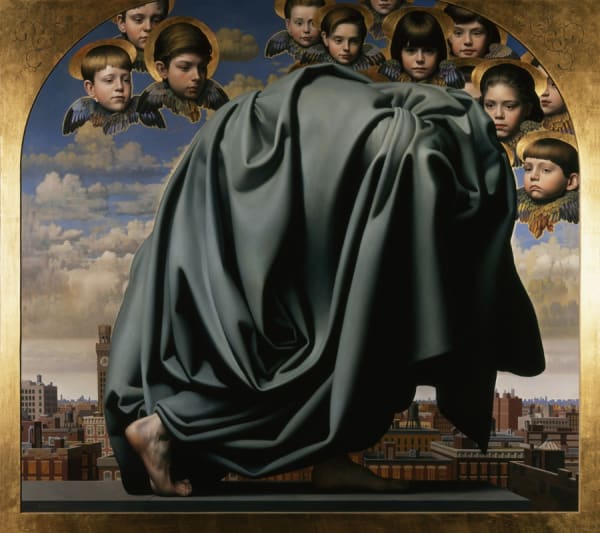The commission conversation often starts with, or gets around to, a client telling the chief executive officer of New York's Petzel Gallery that they love the work of one of the artists represented by the gallery… it's just that none of the pieces currently in the gallery is right for a particular space in their home or, if they represent a corporation or nonprofit agency, a lobby or some other public area. That's when Andrea Teschke, also a partner in the gallery, brings up the idea of a private commission. "It happens with some regularity and with some artists more than others," she tells Observer.
Petzel Gallery doesn't advertise that some of its artists take private commissions, and most clients don't think to ask, she says. But perhaps they should. Many art galleries are happy to entertain the prospect of a private commission for the artists they represent. "One of our strengths is the nurturing and management of private or public commissions by a number of sculptors of the gallery," says Mary Sabbatino, vice president and partner at New York's Galerie Lelong. With private collectors, "the client may see an artwork in the gallery that is sold and ask if the artist can make something in the same 'family.' At that point, we discuss a commission. Some artists are open to this and like the challenge, while others feel the idea is finished."
At both Galerie Lelong and Petzel, the price of a ready-made piece and one that is commissioned are the same-the only difference being there are no discounts (five or ten percent, customarily) for artworks the artist already has produced. Private commissions create a "pride factor" on the part of buyers who see themselves as part of the creative process in terms of indicating what they want and seeing that come to life. In the process, they acquire not just an object but also a story about the piece. A private commission allows them to talk about the artist and their relationship with that person, as well as the genesis of the artwork and how it progressed. That extra involvement adds considerable personal value to the commissioned work.
For the gallery, there rarely are any drawbacks other than perhaps one fewer work for the gallery to exhibit. Among the many benefits is the fact that the connection between buyer, artist and gallery becomes closer, which makes future purchases of that or some other artist's work at the gallery more likely.
That said, artist commissions can create extra work for galleries. Teschke stated that the gallery handles all communication between artist and buyer (the two never actually speak, text or email each other), and according to Liz Bower, a director at Galerie Lelong, "private commissions are much more time-consuming than other sales," and often require the writing of a contract, which "can get quite lengthy, such as those for [sculptor] Andy Goldsworthy, all of whose pieces are site-specific." Pages and pages of details lay out the timeline of a project, starting with the artist visiting the site and then creating a proposal, how and when the proposal is approved, how and when the completed sculpture is installed, how the piece will be maintained, the price of the artwork and how payments will be made, travel costs and fabrication fees.
Painter Robert Kushner has "done quite a lot of private commissions, most of which have come through my dealer," D.C. Moore Gallery in New York. Known as a leader in the pattern and decoration movement, he creates "things that people want to live with." One client was a woman in Seattle, Washington who wanted him to paint images on doors for a walk-in closet in her home: "I met the woman during a site visit, and I liked her. I really liked her art collection and wanted my work to be part of that." Another client was Manhattan restaurateur Danny Meyer who commissioned Kushner to cover the walls of his Gramercy Tavern, a work that measured six feet by ninety feet. "We negotiated the exact size, the due date and the price. I asked him what he was looking for, and he told me 'étonnez-moi,' astonish me."
Another artist who regularly accepts private commissions is painter Will Wilson, a long-time West Coast artist who currently resides in San Miguel de Allende, Mexico and is represented by Gallery Henoch in New York City. "A lot of the people who have bought my works in a gallery also want me to do a commission," he tells Observer. One of those people was Michael Jackson, who had seen a show of his paintings at San Francisco's John Pence Gallery and was interested in a particular work on display. "The one he wanted, which was called 'Sleepwalking,' was already sold, but I asked that buyer for permission to make another version of it, and he said yes," and that was his first commissioned work for the singer. Not long after, Jackson asked him to paint an image for one of his last albums, Blood on the Dance Floor: HIStory in the Mix.
Working one-on-one with a specific client appeals to some artists more than others. "I've always liked the people who want to commission me," Wilson says. "When someone buys my work, I'm disposed to like them." Kushner, on the other hand, keeps stricter boundaries. Visiting his studio, for instance, is not a client's right. "My studio is sacred. I let people know that this is a privilege."
Requests for private commissions are not always granted. Artists may bristle at being told what to do and what colors to use. "One out-of-towner said to me, 'I love your work, but I hate pink,'" Kushner recalls. "I use a lot of pink, so that didn't work out." They may also be loath to do something they've done before. "Been-there-done-that, probably not; but slightly out of the ordinary gets an artist's attention," says one New York City gallery owner who prefers to stay anonymous. And an artist may simply not have the time, or a proposed subject may not appeal to them. "A corporation wanted me to include some of its products in a still-life," Massachusetts painter Scott Prior tells Observer. He ended up saying no to the commission.


